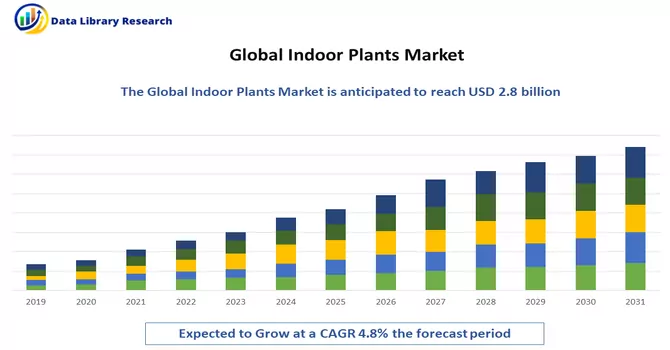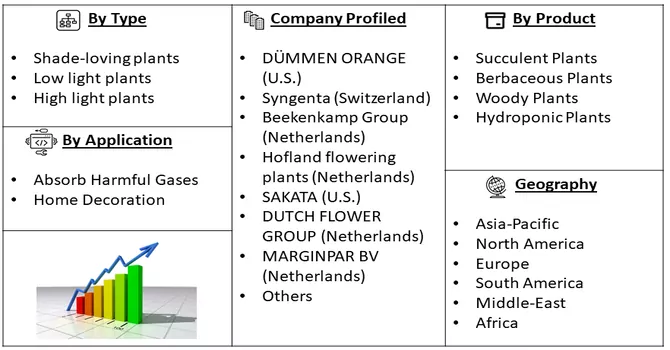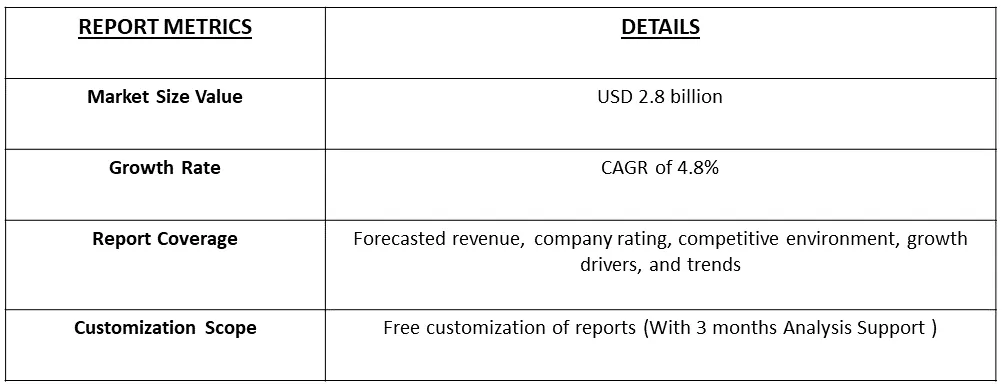The global indoor plants market size was USD 2.8 billion in 2023 and is likely to register a CAGR of 4.8% during 2024–2031.

Get Complete Analysis Of The Report - Download Free Sample PDF
Indoor plants, also known as houseplants or interior plants, are species of plants cultivated and grown inside buildings, residences, offices, or other enclosed spaces. These plants are selected and nurtured for their ability to thrive in indoor environments with varying light, temperature, and humidity conditions. Indoor plants are valued not only for their aesthetic appeal but also for their potential benefits, such as improving indoor air quality by absorbing pollutants and increasing oxygen levels. Common examples of indoor plants include varieties of succulents, ferns, snake plants, pothos, peace lilies, and numerous other species chosen for their adaptability to the indoor setting. Incorporating indoor plants into interior spaces is a popular practice for enhancing the visual ambience, creating a connection with nature, and contributing to a healthier indoor environment.
The indoor plants market is experiencing robust growth driven by a convergence of factors that underscore the increasing appreciation for greenery within indoor spaces. One major contributor is the heightened awareness of the positive impact of indoor plants on well-being, with individuals seeking to create environments that foster mental health and overall wellness. The principles of biophilic design, integrating nature into indoor spaces, further fuel this trend, with indoor plants becoming essential elements of aesthetically pleasing and health-conscious interior decor. Furthermore, the convenience of accessing a diverse array of indoor plants through e-commerce platforms has expanded consumer reach, making it easier for individuals to choose and purchase plants. As environmental consciousness grows, the sustainability and eco-friendliness of indoor plants align with consumer preferences, contributing to their continued popularity. Collectively, these factors signify a dynamic and thriving indoor plants market, where the desire for greenery within indoor spaces continues to resonate with a diverse and increasingly informed consumer base.
Market Segmentation: The Indoor Plants Market is Segmented by Type (Shade-loving plants, Low light plants and High light plants), Application (Absorb Harmful Gases and Home Decoration), Product (Succulent Plants, Berbaceous Plants, Woody Plants and Hydroponic Plants) and Geography (North America, Asia-Pacific, Europe, South America, Middle East, and Africa). The market size and demand forecasts for the pump market in revenue (USD billion) for all the above segments.

For Detailed Market Segmentation - Download Free Sample PDF
The indoor plants market is experiencing a transformative phase marked by several noteworthy trends. A prominent shift toward wellness-centric plants is evident, with consumers increasingly seeking indoor plants known for their air-purifying and stress-relieving qualities. Biophilic design principles are playing a pivotal role, as interior spaces embrace the integration of indoor plants to create environments that foster a stronger connection with nature, promoting overall well-being. Sustainability is a key theme, with eco-conscious consumers prioritizing indoor plants cultivated through responsible and environmentally friendly practices. The convenience of online plant shopping has led to the proliferation of e-commerce platforms dedicated to indoor plants, offering a diverse selection and facilitating seamless delivery. Thus, these market trends are expected to drive the growth of the studied market over the forecast period.
Market Drivers:
Health Benefits Associated with Indoor Gardening
Indoor gardening serves as a holistic approach to promoting health and well-being, encompassing various benefits for both the physical and mental aspects of individuals. One significant advantage is the improved air quality within indoor spaces, as indoor plants function as natural air purifiers, absorbing pollutants and releasing oxygen. Engaging in indoor gardening has been correlated with stress reduction and enhanced mental well-being, providing a calming and therapeutic environment. The visual appeal of greenery and the act of caring for plants contribute to elevated mood and increased creativity, fostering a positive atmosphere. Indoor gardens create a therapeutic space, allowing individuals to connect with nature and experience the sensory elements of soil and foliage. The presence of indoor plants has been associated with better concentration and productivity, making them beneficial additions to work or study areas. Additionally, indoor plants act as natural humidifiers, releasing moisture into the air and alleviating issues related to dry indoor environments. In urban settings where access to outdoor green spaces is limited, indoor gardening provides a means to connect with nature, fulfilling an innate human need for such connections. Thus, these factors are expected to drive the growth of the studied market over the forecast period.
Increasing Popularity of Indoor Plants as Interior Decoration
The surge in the popularity of indoor plants as a form of interior decoration signifies a notable transformation in design preferences, emphasizing a growing appreciation for the aesthetic and functional qualities that greenery introduces to indoor spaces. This trend is closely linked to the ascent of biophilic design principles, which underscore the integration of natural elements within interiors to establish a balanced and harmonious ambiance. From sleek succulents to lush tropical varieties, indoor plants have evolved into essential components of modern interior design, elevating the visual allure of homes, offices, and commercial establishments. Their versatility enables seamless integration with diverse design styles, allowing them to enhance minimalist, modern, eclectic, or bohemian aesthetics.
The appeal of indoor plants extends beyond their green foliage, encompassing creative planter choices, hanging pots, and innovative arrangements that contribute to the overall design scheme. The trend involves the strategic use of indoor plants as focal points or clustered features within spaces, turning them into visually captivating elements. Furthermore, the resurgence of interest in retro and vintage design has sparked a renewed fascination with iconic plants from past eras, adding a touch of nostalgia and timeless elegance to contemporary interiors. The wellness movement plays a pivotal role in the growing preference for indoor plants, as individuals increasingly recognize the positive impact of greenery on mental well-being. In urban environments where access to nature is limited, indoor plants offer a solution to bring the outdoors inside, fostering a serene and stress-free living or working environment. Additionally, the accessibility of plant care information and the availability of a diverse range of indoor plants through online platforms empower individuals to embrace a DIY approach to indoor gardening, cultivating a more hands-on and personalized connection with their living spaces. Thus, these factors are expected to drive the growth of the studied market over the forecast period.
Market Restraints:
Seasonal Variability
The dynamic and seasonal nature of the indoor plants market presents inherent challenges that necessitate careful consideration and strategic management. Demand for indoor plants can exhibit fluctuations influenced by various factors, including holidays, shifts in weather conditions, and seasonal preferences. This variability underscores the importance of proactive planning and effective inventory management to navigate the market successfully. During the winter months, the challenge intensifies due to shorter days and limited natural light availability. To address this, it is advisable to strategically position plants near windows to maximize exposure to sunlight. In instances where natural light proves inadequate, supplementation through artificial lighting becomes crucial. This highlights the need for innovative solutions, such as incorporating supplementary light sources, to ensure the vitality and appeal of indoor plants throughout the changing seasons. Managing these seasonal dynamics requires a nuanced approach, combining market awareness with adaptive strategies to meet the evolving demands of consumers.
Segmental Analysis:
Shade-loving plants Segment is Expected to Witness Significant Growth over the Forecast Period
Shade-loving indoor plants have gained popularity as versatile and resilient options for those seeking greenery in spaces with limited natural light. These plants have adapted to thrive in low-light conditions, making them ideal choices for interiors with shaded areas or rooms where direct sunlight is scarce. One popular shade-loving plant is the Snake Plant (Sansevieria), known for its ability to tolerate low light and purify indoor air.
Another notable option is the Peace Lily (Spathiphyllum), which not only flourishes in shade but also produces elegant white blooms. The ZZ Plant (Zamioculcas zamiifolia) is recognized for its resilience in low-light environments and its attractive glossy foliage. Philodendrons, such as the Heartleaf Philodendron (Philodendron hederaceum), are excellent shade-loving choices, appreciated for their trailing vines and heart-shaped leaves. Pothos varieties, including the Devil's Ivy (Epipremnum aureum), are renowned for their adaptability to low light and ease of care. The Cast Iron Plant (Aspidistra elatior) is celebrated for its ability to thrive in low-light conditions and withstand neglect. Shade-loving indoor plants offer the flexibility to enhance interior spaces that might not receive ample sunlight. Their diverse shapes, sizes, and leaf patterns contribute to creating visually appealing and dynamic indoor environments. These plants not only bring greenery into homes and offices but also contribute to a healthier indoor atmosphere by helping to purify the air. The popularity of shade-loving indoor plants reflects a growing appreciation for their adaptability, low-maintenance characteristics, and the ability to introduce a touch of nature to various indoor settings, even in areas with limited natural light. Thus, these factors are expected to drive the growth of the segment over the forecast period.
Home Decoration Segment is Expected to Witness Significant Growth over the Forecast Period
Home decoration with indoor plants has emerged as a popular and visually captivating trend, offering a harmonious blend of nature and design within living spaces. The diverse selection of indoor plants provides homeowners with creative options to enhance the aesthetic appeal of their homes. Incorporating plants into home decor involves thoughtful considerations, such as selecting the right plants for different rooms. Larger statement plants like the Fiddle Leaf Fig may grace living rooms, while compact succulents or cacti find suitable homes on kitchen shelves. Vertical gardens or green walls represent innovative ways to infuse greenery into the decor, transforming blank walls into vibrant, living focal points. Functional decor takes center stage as herbs like basil or rosemary not only add a fresh aesthetic to kitchens but also serve culinary purposes. Grouping plants, creating natural room dividers, and experimenting with seasonal variations contribute to dynamic and visually stimulating arrangements. Terrariums and miniature gardens add whimsy to tabletops, while considering lighting conditions ensures that each plant thrives in its designated space. Beyond aesthetics, caring for indoor plants becomes a fulfilling routine, fostering a connection with nature and contributing to the overall well-being of the home environment. In essence, the integration of indoor plants into home decor offers a versatile and fulfilling means of creating personalized, inviting, and visually captivating living spaces.
Hydropaunics Segment is Expected to Witness Significant Growth over the Forecast Period
Hydroponics, an innovative method of cultivating plants without soil, has gained popularity in the realm of indoor gardening. This technique offers numerous advantages for the growth and maintenance of indoor plants. By delivering a precise and controlled nutrient solution directly to the plant roots, hydroponics ensures optimal nutrient balance, promoting robust and healthy growth. Its water-efficient nature, with the ability to recirculate water, addresses concerns of limited resources in indoor environments. Improved aeration of plant roots prevents issues like overwatering and soil-borne diseases, contributing to healthier root systems and overall plant vitality. The absence of soil not only reduces the risk of pests but also makes hydroponics a neater and more compact solution for indoor spaces. This method enables year-round cultivation, providing a continuous harvest for indoor gardeners regardless of external weather conditions. As technology advances, hydroponics continues to be an exciting and accessible option for those seeking sustainable, efficient, and space-efficient indoor gardening practices. Thus, such factors are expected to drive the growth of the studied market over the forecast period.
North America Region is Expected to Witness Significant Growth over the Forecast Period
In North America, the appreciation for indoor plants has flourished, becoming a prominent aspect of interior design and lifestyle choices. The diverse climate and the prevalence of urban living have contributed to the popularity of incorporating greenery into indoor spaces. Homeowners, businesses, and institutions across the United States and Canada have embraced the aesthetic and wellness benefits of indoor plants. The trend extends beyond traditional potted plants to encompass creative arrangements, hanging gardens, and vertical plant displays. In major cities like New York, Los Angeles, Toronto, and Vancouver, the demand for indoor plants has spurred the growth of specialized nurseries and plant shops. The movement towards biophilic design, which seeks to connect people with nature in their built environments, has further fueled the popularity of indoor plants. Beyond aesthetics, indoor plants are valued for their air-purifying qualities and positive impact on mental well-being, addressing the desire for healthier living spaces. The presence of indoor plant communities and social media platforms dedicated to plant enthusiasts underscores the significance of this trend. With an increasing emphasis on sustainability and wellness, the relationship between North America and indoor plants continues to thrive, shaping the way people interact with and incorporate nature into their indoor environments. Thus, such factors are expected to drive the growth of the market over the forecast period.

Get Complete Analysis Of The Report - Download Free Sample PDF
In the competitive landscape of the indoor plants market, a comprehensive understanding of key players is essential. This entails a detailed analysis of competitors, encompassing various aspects such as company overview, financial standing, revenue generation, market potential, investment in research and development, initiatives for new market penetration, global footprint, production sites and facilities, production capacities, as well as an assessment of company strengths and weaknesses. Additionally, insights into recent product launches, the scope and diversity of product offerings, and the dominance of applications further contribute to a holistic view of the competitive dynamics within the indoor plants market. This in-depth exploration aims to provide stakeholders with valuable insights for strategic decision-making, fostering a nuanced understanding of the competitive landscape and positioning of key players in this flourishing market segment. Some of the major players operating in the indoor plants market are:
Recent Development:
1) In January 2022, Bloomscape made a significant impact on the market by unveiling its revolutionary Bloomscape app. This application marked a transformative step forward, offering users a seamless and enhanced experience for both purchasing and caring for plants. Through the app, Bloomscape aimed to streamline the entire process, from selecting the ideal indoor plants to providing comprehensive care guidance, catering to plant enthusiasts seeking convenience and expertise in their plant-related endeavors.
2) In March 2021, The Plant Exchange introduced its pioneering Plant Exchange app, introducing a novel approach to the world of indoor plants. This innovative application created a platform for plant enthusiasts to engage in the trading and selling of their beloved plants with unparalleled simplicity. The Plant Exchange app facilitated a community-driven exchange, fostering connections among indoor plant aficionados who sought to share and acquire unique specimens. The introduction of this app reflected a commitment to transforming the plant enthusiast experience by leveraging technology to facilitate plant transactions and build a thriving community around the shared love for indoor greenery.
Q1. What was the Indoor Plants Market size in 2023?
As per Data Library Research the global indoor plants market size was USD 2.8 billion in 2023.
Q2. At what CAGR is the Indoor Plants market projected to grow within the forecast period?
Indoor Plants Market is expected to register a CAGR of 4.8% over the forecast period.
Q3. What segments are covered in the Indoor Plants market Report?
By Type, Application, Product and Geography these segments are covered in the Indoor Plants market Report.
Q4. What are the Growth Drivers of the Indoor Plants Market?
Key factors that are driving the growth include the Health Benefits Associated with Indoor Gardening and Increasing Popularity of Indoor Plants as Interior Decoration.
Data Library Research are conducted by industry experts who offer insight on industry structure, market segmentations technology assessment and competitive landscape (CL), and penetration, as well as on emerging trends. Their analysis is based on primary interviews (~ 80%) and secondary research (~ 20%) as well as years of professional expertise in their respective industries. Adding to this, by analysing historical trends and current market positions, our analysts predict where the market will be headed for the next five years. Furthermore, the varying trends of segment & categories geographically presented are also studied and the estimated based on the primary & secondary research.
In this particular report from the supply side Data Library Research has conducted primary surveys (interviews) with the key level executives (VP, CEO’s, Marketing Director, Business Development Manager and SOFT) of the companies that active & prominent as well as the midsized organization
FIGURE 1: DLR RESEARH PROCESS

Extensive primary research was conducted to gain a deeper insight of the market and industry performance. The analysis is based on both primary and secondary research as well as years of professional expertise in the respective industries.
In addition to analysing current and historical trends, our analysts predict where the market is headed over the next five years.
It varies by segment for these categories geographically presented in the list of market tables. Speaking about this particular report we have conducted primary surveys (interviews) with the key level executives (VP, CEO’s, Marketing Director, Business Development Manager and many more) of the major players active in the market.
Secondary ResearchSecondary research was mainly used to collect and identify information useful for the extensive, technical, market-oriented, and Friend’s study of the Global Extra Neutral Alcohol. It was also used to obtain key information about major players, market classification and segmentation according to the industry trends, geographical markets, and developments related to the market and technology perspectives. For this study, analysts have gathered information from various credible sources, such as annual reports, sec filings, journals, white papers, SOFT presentations, and company web sites.
Market Size EstimationBoth, top-down and bottom-up approaches were used to estimate and validate the size of the Global market and to estimate the size of various other dependent submarkets in the overall Extra Neutral Alcohol. The key players in the market were identified through secondary research and their market contributions in the respective geographies were determined through primary and secondary research.
Forecast Model
